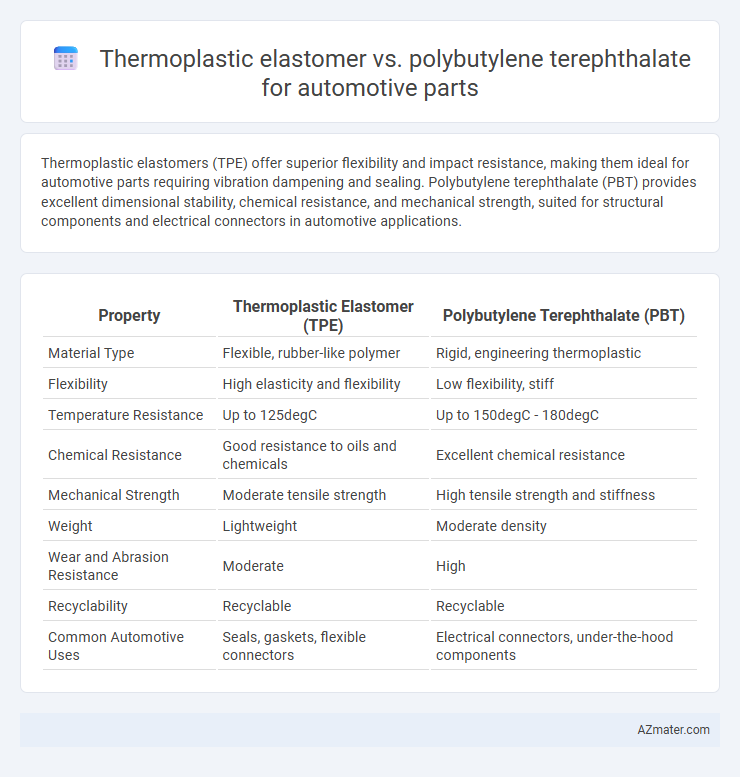Thermoplastic elastomers (TPE) offer superior flexibility and impact resistance, making them ideal for automotive parts requiring vibration dampening and sealing. Polybutylene terephthalate (PBT) provides excellent dimensional stability, chemical resistance, and mechanical strength, suited for structural components and electrical connectors in automotive applications.
Table of Comparison
| Property | Thermoplastic Elastomer (TPE) | Polybutylene Terephthalate (PBT) |
|---|---|---|
| Material Type | Flexible, rubber-like polymer | Rigid, engineering thermoplastic |
| Flexibility | High elasticity and flexibility | Low flexibility, stiff |
| Temperature Resistance | Up to 125degC | Up to 150degC - 180degC |
| Chemical Resistance | Good resistance to oils and chemicals | Excellent chemical resistance |
| Mechanical Strength | Moderate tensile strength | High tensile strength and stiffness |
| Weight | Lightweight | Moderate density |
| Wear and Abrasion Resistance | Moderate | High |
| Recyclability | Recyclable | Recyclable |
| Common Automotive Uses | Seals, gaskets, flexible connectors | Electrical connectors, under-the-hood components |
Introduction to Thermoplastic Elastomer and Polybutylene Terephthalate
Thermoplastic elastomers (TPE) combine the elastic properties of rubber with the easy processing of plastics, making them ideal for automotive parts requiring flexibility and durability. Polybutylene terephthalate (PBT) is a semi-crystalline engineering thermoplastic known for high chemical resistance, dimensional stability, and excellent electrical insulation, commonly used in automotive connectors and housings. Comparing TPE and PBT reveals trade-offs in flexibility versus structural rigidity, impacting material selection based on part function and performance requirements.
Material Composition and Structure
Thermoplastic elastomers (TPE) combine rubber-like elasticity with thermoplastic processability, comprised of block copolymers with soft and hard segments that provide flexibility and durability. Polybutylene terephthalate (PBT) is a semi-crystalline polyester made from butanediol and terephthalic acid, known for its rigidity, high tensile strength, and excellent chemical resistance. In automotive parts, TPE's flexible, impact-resistant nature suits seals and gaskets, while PBT's structural integrity and thermal stability are ideal for connectors and housings.
Mechanical Properties Comparison
Thermoplastic elastomers (TPE) offer superior flexibility and impact resistance, making them ideal for automotive parts requiring vibration damping and elasticity. Polybutylene terephthalate (PBT) exhibits higher tensile strength, rigidity, and thermal resistance, suitable for structural components exposed to mechanical stress and elevated temperatures. The choice between TPE and PBT depends on the specific mechanical demands, with TPE favored for durability under dynamic loads and PBT preferred for dimensional stability and mechanical strength.
Thermal Stability and Heat Resistance
Thermoplastic elastomers (TPE) exhibit excellent thermal stability and maintain flexibility at elevated temperatures, making them ideal for automotive parts exposed to fluctuating heat conditions. Polybutylene terephthalate (PBT) offers superior heat resistance with a melting point around 223degC, ensuring durability and dimensional stability in high-temperature engine environments. The choice between TPE and PBT depends on the specific thermal demands, with PBT preferred for rigid parts requiring high heat endurance and TPE for components needing elasticity and thermal resilience.
Chemical Resistance in Automotive Environments
Thermoplastic elastomers (TPE) exhibit superior chemical resistance to automotive fluids such as oils, fuels, and antifreeze compared to polybutylene terephthalate (PBT), making TPE ideal for sealing and flexible components in harsh environments. PBT offers good resistance to hydrocarbons and many solvents but can degrade when exposed to strong acids or bases commonly found in automotive systems. Selecting TPE for automotive parts enhances durability and performance by withstanding aggressive chemicals, thermal cycling, and mechanical stress typical in engine compartments and fluid handling applications.
Processing and Manufacturability
Thermoplastic elastomers (TPE) offer superior flexibility and ease of processing with injection molding and extrusion, enabling faster cycle times and simplified molding of complex shapes compared to polybutylene terephthalate (PBT). PBT provides excellent dimensional stability and high tensile strength but requires higher processing temperatures and more precise control to avoid thermal degradation during injection molding. The manufacturability of TPE favors applications needing elastomeric properties and reduced secondary processes, while PBT is preferred for rigid automotive parts demanding chemical resistance and structural integrity.
Cost-Effectiveness for Mass Production
Thermoplastic elastomers (TPE) offer superior flexibility and impact resistance compared to polybutylene terephthalate (PBT), which enhances durability in automotive parts but often at a higher material cost. PBT provides excellent dimensional stability, chemical resistance, and faster cycle times during injection molding, contributing to lower manufacturing costs in high-volume production. For cost-effectiveness in mass production, PBT typically delivers better overall value due to its efficiency in processing and strong mechanical properties suited for automotive components requiring structural integrity.
Application Areas in Automotive Parts
Thermoplastic elastomers (TPE) are widely used in automotive parts such as seals, gaskets, weatherstripping, and flexible components due to their excellent flexibility, impact resistance, and vibration damping properties. Polybutylene terephthalate (PBT) is favored for under-the-hood applications, connectors, lighting components, and structural parts because of its high mechanical strength, chemical resistance, and thermal stability. Both materials serve crucial roles in automotive manufacturing, with TPE focusing on flexible, soft-touch parts and PBT on rigid, durable components.
Sustainability and Recycling Potential
Thermoplastic elastomers (TPEs) offer significant sustainability advantages in automotive parts due to their recyclability and lower energy consumption during processing compared to polybutylene terephthalate (PBT), which is less recyclable and often downcycled. TPEs enable closed-loop recycling processes, reducing material waste and lowering the vehicle's overall carbon footprint. In contrast, PBT's chemical resistance and durability support long-term use but pose challenges in recycling streams, limiting its sustainability potential in automotive applications.
Choosing the Right Material for Automotive Applications
Thermoplastic elastomers (TPE) offer excellent flexibility, impact resistance, and vibration damping, making them ideal for automotive components such as seals, gaskets, and interior trim. Polybutylene terephthalate (PBT) provides high stiffness, chemical resistance, and dimensional stability, suitable for under-the-hood parts like connectors and housings. Selecting between TPE and PBT depends on the specific requirements of durability, thermal performance, and mechanical properties critical for the automotive environment.

Infographic: Thermoplastic elastomer vs Polybutylene terephthalate for Automotive part
 azmater.com
azmater.com